I’ll be updating this post with ongoing announcements about the huge earthquake that is occurring in the Tohoku region of Japan. It has been labelled in Japanese the 東北地方太平洋沖地震 (Tohoku-chiho Taiheiyo-oki Jishin), the biggest earthquake ever to hit Japan. It struck at 14.46 with a magnitude of 9.0 and was assigned the highest level 7 on the Japanese earthquake scale.
The effects were felt 500km North-South and 200km East-West with big aftershocks continuing for days later. I was in central Japan (near Nagoya) when it struck and felt the building swaying for several minutes. Friends in Kansai (Osaka, Kyoto) also reported feeling it. This earthquake reportedly had 32 times the energy of the Great Kanto earthquake of 1923. It initially shook Tokyo and the northern cities Sendai and Iwate for minutes, producing huge tsunamis afterwards that reached 10m in height. There are also reports that it was felt in Beijing.
The quake struck at a depth of 32 km, about 130 km off the eastern coast. The area is 380 km northeast of Tokyo.
.::: Click here for updates below! :::.
Follow me on Twitter for live updates.
Quick Links and Information
Leave a comment if you have any additional information, especially if you are in Japan.
Controlled Blackout Listings:
Check by zip code: http://www.google.co.jp/intl/ja/crisisresponse/japanquake2011_power.html
Schedule: https://sites.google.com/a/creco.net/teiden-calendar/
Official TEPCO homepage: http://www.tepco.co.jp/index-j.html
Getting in Touch
Docomo: http://dengon.docomo.ne.jp/Einoticelist.cgi?es=0
AU: http://dengon.ezweb.ne.jp/E/service.do?p1=dmb221
Softbank: http://dengon.softbank.ne.jp/pc-e1.jsp
Person Finder: http://japan.person-finder.appspot.com/?lang=en
Google Response site: http://www.google.co.jp/intl/en/crisisresponse/japanquake2011.html
Emergency Messaging Service: If stranded and you need to message someone, dial 171, then 1, then your own home phone number, then leave your message. To pick up a message, it’s 171, then 2, then your home phone number (the number you think the stranded person would have left).
An emergency line has been set up for non-Japanese speakers, on 050 5814 7230 and 03 5366 6001. English, Chinese, Korean are available 24 hours a day. Portuguese and Spanish between 9am-8pm.
Quake and Tsunami Information
Tsunami Information: http://www.jma.go.jp/en/tsunami/
Earthquake Information: http://www.jma.go.jp/en/quake/
Earthquake List (Yahoo Japan): http://typhoon.yahoo.co.jp/weather/jp/earthquake/
Earthquake List (US): http://earthquake.usgs.gov/earthquakes/recenteqsww/Maps/10/140_35_eqs.php
Live Streams
NHK Official (April 8th): http://www.ustream.tv/channel/kamori
NHK World (English): http://www3.nhk.or.jp/nhkworld/r/movie/
NHK World in English: http://www.ustream.tv/channel/nhk-world-tv
NHK Official Ustream: http://www.ustream.tv/channel/nhk-gtv (Mirror) (Mirror)
TBS Japanese: http://www.ustream.tv/channel/tbstv
Alijazeera English: http://english.aljazeera.net/watch_now/
Japanese News Channels: http://www.ustwrap.info/multi/7475111::japanhelpchannel::tbstv
Useful Information
People to follow on Twitter for accurate and balanced information: http://search.japantimes.co.jp/cgi-bin/nc20110316a1.html.
Japan Times: http://www.japantimes.co.jp/news/emergency-assistance.html
Timeout Tokyo: http://www.timeout.jp/en/tokyo/feature/2532/japan-earthquake-how-you-can-help
Japan Subculture: http://www.japansubculture.com/2011/03/tohoku-disaster-how-to-help/
Who can and can’t give blood in Japan: http://www.mutantfrog.com/2011/03/13/who-can-and-can-not-donate-blood-in-japan/
A note on energy conservation: http://www.mutantfrog.com/2011/03/13/a-note-on-energy-conservation/ from Mutantfrog
Distance Calculator: http://distancecalculator.globefeed.com/Japan_Distance_Calculator.asp
Shelter Map: View Google map here.
Live Updates
17.18 Just after 3pm the Japan Quake Map recorded its 1000th quake since the beginning on March 11th. It uses data from the USGS and only shows earthquakes with a Magnitude of 4.5 or greater. Earthquakes that fall around the original fault line of 450km length by 150km width are designated as aftershocks. Technically then, the 1000 number is a bit arbitrary, but it’s still absolutely huge…
Q: Foreshocks, aftershocks – what’s the difference?
A: “Foreshock” and “aftershock” are relative terms. Foreshocks are earthquakes which precede larger earthquakes in the same location. Aftershocks are smaller earthquakes which occur in the same general area during the days to years following a larger event or “mainshock”, defined as within 1-2 fault lengths away and during the period of time before the background seismicity level has resumed. As a general rule, aftershocks represent minor readjustments along the portion of a fault that slipped at the time of the main shock. The frequency of these aftershocks decreases with time. Historically, deep earthquakes (>30km) are much less likely to be followed by aftershocks than shallow earthquakes. (Univ. of Washington)
http://earthquake.usgs.gov/learn/faq/?categoryID=1&faqID=99
http://www.jma.go.jp/jma/en/2011_Earthquake/2011_Earthquake_SourceProcess.pdf
PDF for Posterity
17.08 Useful information in the Japan Times on aftershocks.
Why do aftershocks occur?
Because tectonic plates and faults try to stabilize ground conditions that have been greatly altered by a huge earthquake.
Why do we have so many big aftershocks?
The magnitude of the largest aftershocks tend to be about 1.0 magnitude lower than the main quake, which was 9.0, said Yoshiro Ota of the Meteorological Agency.
“People tend to think aftershocks are small. But a magnitude 8 is huge. Magnitude 7 is also huge, so we should be very careful,” Ota said.
How many aftershocks have there been? How big have they been?
As of 5 p.m. Tuesday, there have been 408 aftershocks with a magnitude of 5.0 and above, 68 registering 6.0 and higher and five at the 7.0 level or higher, according to the Meteorological Agency, which does not count aftershocks smaller than those with a magnitude of 5.0.
“On average, we have about 10 quakes a year with magnitude of 7.0 or higher, and we already had six in the past month. One of them was the gigantic 9.0,” Ota said.
The number of aftershocks following the March 11 quake have been by far the most recorded in Japan. The magnitude 8.2 quake off eastern Hokkaido in 1994 had 117 aftershocks with a magnitude of 5.0 above, making it the quake with the second-highest number of aftershocks on record in the country.
The number of aftershocks is high because such a large part of the tectonic plate was affected.
Will we have any more huge aftershocks soon?
Maybe. The three largest aftershocks occurred within an hour of the main quake, as is the case with most earthquakes.
But that does not mean the worst is over. April 7 and 11 saw aftershocks with magnitudes of 7.1 and 7.0 respectively.
And the Meteorological Agency warned that many more large ones may be in store for eastern Japan.
The agency said the likelihood of an aftershock of magnitude 7.0 or higher is 10 percent within three days of 3 p.m. Tuesday, and also the same percentage within three days of 3 p.m. Friday.
On the Japanese seismic intensity scale to 7, the largest April aftershocks were an upper 6. The main quake topped the Japanese scale at 7 in Miyagi Prefecture on March 11.
“It is possible to have a ‘shindo’ 7 if the epicenter of a magnitude 7 aftershock is on land and its focus is shallow,” Ota said.
What is shindo? How is it different from magnitude?
Shindo, which literally means tremble degree, describes the degree of shaking in a particular place, while magnitude is the energy of an earthquake.
Therefore, the March 11 quake recorded different shindo in different locations.
For example, central Tokyo generally felt a shindo 5 after the magnitude 9.0 quake, while Kurikoma, Miyagi Prefecture, experienced a shindo 7 in the same quake. Shindo does not only depend on magnitude, but also the distance from the epicenter and the depth of the quake.
Also, if an interval of two quakes is short, shindo cannot describe the degree of shaking from one single quake.
How much longer will aftershocks last?
Who knows? “The Great East Japan Earthquake was so huge that we cannot make reasonable predictions from past quakes,” Ota said. Some experts say they could last at least a year.
http://search.japantimes.co.jp/cgi-bin/nn20110414a5.html
April 14th, 2011
12.26 An excellent article from the Asashi Shimbun examining the early events of the disaster and what may have led to the situation at Fukushima. Much of what is written is insider information and stuff that I imagine may have been off the record, so take it with a pinch of salt. I hope copied the entire article here for posterity, as often news websites have a habit of moving their articles or restricting access after a while.
WHAT WENT WRONG: Fukushima flashback a month after crisis started
One month after the Great East Japan Earthquake struck, The Asahi Shimbun re-examined the events surrounding the accident at the Fukushima No. 1 nuclear power plant to determine what exactly happened.
* * *
At 3:42 p.m. March 11, 56 minutes after the Great East Japan Earthquake struck, all but one of the emergency diesel generators at the Fukushima No. 1 nuclear power plant were knocked out after a tsunami that exceeded 14 meters engulfed the six reactors at the plant.
An official at the emergency response center of the Nuclear and Industrial Safety Agency (NISA), located in the annex building of the Ministry of Economy, Trade and Industry, ran out into the hallway and read out a memo in a loud voice.
“All AC power sources lost at the No. 1 to No. 5 reactors at the Fukushima No. 1 nuclear power plant! Only the B emergency diesel generator at the No. 6 reactor is working!”
All lights and instruments at the central control rooms of the Fukushima No. 1 plant had gone out. Workers connected car batteries to the instruments and used flashlights to read the data that showed what was happening in the reactor cores.
At the headquarters of Tokyo Electric Power Co., the plant operator, in Tokyo’s Uchisaiwaicho district, executives were ashen-faced when they were told, “The reactor cores cannot be cooled without power sources.”
TEPCO President Masataka Shimizu was in the Kansai region on a business trip, and Chairman Tsunehisa Katsumata was also in China on a business trip.
The seven NISA officials who were at the Fukushima No. 1 plant headed for the off-site center located about five kilometers away. The center is where the headquarters is set up locally to deal with any natural disaster that hits the nuclear plant and is designed to allow for constant monitoring of the plant.
However, the power outage and loss of communications channels in the immediate aftermath of the quake and tsunami meant no data was reaching the officials at the center.
At 5:45 p.m., NISA official Koichiro Nakamura said at a news conference, “While water continues to be pumped into (the reactor cores), we do not know what the water level is.”
The reactor cores were, in fact, gradually heading out of control.
When the earthquake struck, Prime Minister Naoto Kan was facing a crisis of a political nature.
At an Upper House Audit and Oversight of Administration Committee session, Kan was asked about political donations his political fund management organization had received from a foreigner.
While he was responding, the chandelier in the committee room began swaying wildly. Committee Chairman Yosuke Tsuruho said, “Please take cover under the desks.”
The committee session immediately went into recess.
At about 2:50 p.m., Chief Cabinet Secretary Yukio Edano arrived at the Prime Minister’s Official Residence and ran to the crisis management center in the basement. A few minutes later, Kan also returned from the Diet.
Goshi Hosono, Kan’s special adviser, told reporters, “All the Cabinet ministers will be called together.”
Although the ministers began arriving, a few minutes later Edano instructed all the ministers except himself and Ryu Matsumoto, the state minister in charge of disaster management, to return to their respective ministry offices.
As the ministers left the Prime Minister’s Official Residence, Justice Minister Satsuki Eda said, “I don’t know who gave the instruction (to return to the ministries).”
There were already signs from the very beginning of confusion in the chain of command.
The No. 1 to No. 3 reactors at the Fukushima No. 1 nuclear power plant that were operating when the earthquake hit all stopped automatically immediately after the quake hit.
About an hour later came the announcement that all AC power sources to the No. 1 to No. 5 reactors had been lost. At about 4:30 p.m., cooling water was no longer being pumped into the No. 1 and No. 2 reactors.
At about that time, TEPCO officials issued a report to those at the Prime Minister’s Official Residence that said in part, “There will be no problem for eight hours even if no cooling (of the reactors) occurs.”
The eight hours is the amount of time emergency batteries can be used if all AC power sources are lost.
TEPCO officials likely believed that the cooling function could be restored within that time frame.
That evening, Haruki Madarame, chairman of the Nuclear Safety Commission of Japan, visited the Prime Minister’s Official Residence and said, “The situation is not one in which radiation is leaking to the outside atmosphere. While there are problems with the power source, the nuclear chain reaction has been completely stopped. The only thing left is to cool the reactors.”
At about 5 p.m., Kan addressed the nation and said, “While some of the nuclear power plants automatically stopped operations, there has been no confirmation so far of any effects from radioactive materials to the outside atmosphere.”
His comment clearly reflects the opinions of experts within the government.
At a news conference at 7:45 p.m., Edano explained why the government had issued a declaration of a state of emergency at the nuclear power plant.
“If a response can be made within a certain amount of time, concerns and problems will be resolved,” Edano said. “At present, the situation is not one in which damage is likely. Because the effects from what might remotely occur are so severe, we have responded by issuing the declaration to ensure that nothing wrong happens.”
Meanwhile, Fukushima prefectural government officials said they could no longer wait for a decision by the central government and asked residents living within a 2-kilometer radius of the Fukushima plant to evacuate at 8:50 p.m.
The cooling functions had not been restored even after the eight-hour time frame mentioned by TEPCO officials.
The remote possibility of severe consequences that Edano touched upon was moving toward reality by the minute.
At 1:30 a.m. March 12, Madarame and TEPCO officials visited the Prime Minister’s Official Residence and informed Kan and Banri Kaieda, the industry minister, that pressure was rising within the No. 1 reactor at the Fukushima No. 1 plant.
A large volume of steam had accumulated within the reactor’s containment vessel.
Madarame said, “In order to secure the soundness of the containment vessel, there is a need to implement a measure to release internal pressure.”
If the pressure within the containment vessel continued to increase, there was the danger of damage to the vessel. One way to avoid that was to vent the steam inside the vessel to decrease the pressure.
While there was the strong possibility such a move would release radioactive materials into the outside atmosphere, Kan and other government officials agreed that such a move was unavoidable.
At a news conference from about 3 a.m., Edano touched upon the venting process. He also announced that Kan would inspect the nuclear plant site.
Edano was asked if the venting process would be completed before Kan’s visit.
“TEPCO is now conducting final preparations and the measure will be conducted in the near future,” Edano said.
No word about the start of venting reached the Prime Minister’s Official Residence by 6 a.m. When TEPCO officials were asked about when the venting would start, they said, “The power source for the venting has been cut off” and “Workers cannot approach the site to manually vent the pressure because of the high level of radiation.”
At 7 a.m., Kan decided he could not wait any longer and flew to the Fukushima No. 1 plant on a Self-Defense Forces helicopter.
In a van at the site, Kan sat next to TEPCO Executive Vice President Sakae Muto.
In an angry tone, Kan asked Muto, “Why don’t you hurry with the venting?”
Failing to receive a clear answer from Muto, Kan’s anger remained as he entered the local headquarters to deal with the natural disaster.
Banging a desk with his hand, Kan shouted, “Do you know why I decided to come here?”
Kan calmed down when Masao Yoshida, the head of the Fukushima No. 1 plant, told the prime minister the situation would be handled appropriately.
After that exchange, officials of the Prime Minister’s Official Residence began dealing directly with Yoshida and others at the Fukushima plant. That led to a growing gap with TEPCO headquarters in Tokyo.
TEPCO officials began the venting process after 9 a.m., about an hour after Kan left the Fukushima site.
The actual work of opening valves began from after 10 a.m. With pressure within the No. 1 reactor containment vessel falling, the venting process appeared to have worked.
However, at 3:36 p.m., a hydrogen explosion occurred at the No. 1 reactor, blowing away the ceiling of the building housing the reactor.
At a meeting on the evening of March 13 of the Fukushima prefectural government, which was dealing with the natural disaster, Fukushima Governor Yuhei Sato turned his anger on TEPCO officials.
“This is a problem that involves the entire electric power industry,” Sato said. “I hope you will lay your life on the line to deal with the situation.”
In the end, it was unclear who and when the decision to begin venting was made.
At an April 9 news conference at TEPCO headquarters, Muto avoided giving a clear answer, only saying, “Amid a very serious situation, there was a need to make a number of different actions. A clear answer will require further study.”
Opposition party members intend to press the government about when the decision was made as they feel an error was made at the initial stages of dealing with the reactor situation.
On the evening of March 14, officials working at the off-site center near the Fukushima No. 1 plant received word of abnormalities at the No. 2 reactor.
At 6:22 p.m., word was received about the possibility that fuel rods had become exposed above water.
At 8:22 p.m., officials were told of the possibility of a core meltdown.
At 10:22 p.m., word came about the possibility of damage to the core containment vessel.
At about that time, officials at the Prime Minister’s Official Residence were told informally by TEPCO officials that they wanted to evacuate their employees from the Fukushima No. 1 plant.
When he heard that, Kan raised his voice and said, “Is TEPCO planning to abandon its role as an electric power company? Call the company president.”
At about 3:30 p.m. March 15, Kan gathered a few Cabinet ministers and staff members at the Prime Minister’s Official Residence to discuss whether he should go to TEPCO headquarters.
While some participants at the meeting raised legal questions, Edano told Kan, “We shouldn’t be concerned about laws now. You should go to the company headquarters.”
The decision was made at that meeting to set up an integrated headquarters to deal with the nuclear accident. The body would be established at TEPCO headquarters.
Shortly thereafter, Kan met with Shimizu, the TEPCO president.
“What do you intend to do?” Kan asked.
“We will make every effort to protect Fukushima,” Shimizu replied.
“We will set up an integrated headquarters between the government and TEPCO,” Kan said. “Do you agree?”
“Fine,” Shimizu replied.
Shimizu never openly said anything about pulling out of the Fukushima plant.
However, when Kan went to TEPCO headquarters at about 5:30 a.m. and faced company executives in a meeting room, he raised his voice and said, “Pulling out is not an option. We want you to decide on your resolve. If you do decide to pull out, that will mean the total collapse of TEPCO.”
Kan remained at TEPCO headquarters for about three hours. Moving to another room, Kan fell asleep while seated.
Ever since the earthquake, Kan had remained at his office and did not return to his living quarters, working almost around the clock.
From about that time, Kan began taking on more work, telling his aides, “Bring all information to me. I will make the decision” and “I will contact that individual directly.”
That led to a situation described by one high-ranking industry ministry official of “not releasing any information before it was first submitted to the Prime Minister’s Official Residence.”
There was the possibility that such an arrangement affected cooperation among the central government ministries.
Letting Kan sleep for a while at TEPCO headquarters, his staff members finally returned with the prime minister to his official residence at about 8:30 a.m.
In the meantime, strange noises and white smoke emerged from the No. 2 reactor of the Fukushima No. 1 plant. That led to suspicions of damage to the suppression pool.
On the morning of March 14, the upper part of the building housing the No. 3 reactor at the Fukushima No. 1 plant was blown away by a hydrogen explosion.
On the following day, an explosion was heard at the suppression pool of the No. 2 reactor and the building housing the No. 4 reactor was damaged by fire.
White smoke was observed rising from the storage pools containing spent nuclear fuel rods at the No. 3 and No. 4 reactors.
Large volumes of radioactive materials continued to be spewed into the atmosphere.
On March 15, Defense Minister Toshimi Kitazawa held a meeting with high-ranking ministry officials about whether SDF helicopters should be used to dump water on the reactors.
One participant said, “We can estimate how much remains in the storage pool by the way in which steam rises after spraying water.”
Another participant said, “However, if the storage pool is close to empty, a steam explosion could occur if water was suddenly sprayed into it.”
While different opinions were raised, the general mood was to proceed with the water dumping operation.
There was some hesitation, however, because U.S. officials had said that dumping water from the air would be inefficient.
What finally pushed Kitazawa to give the go-ahead was a comment from Kan.
Kitazawa visited the Prime Minister’s Official Residence at about noon on March 16. Kan told him, “I want you to first use SDF helicopters.”
Kitazawa decided to go ahead with the water dumping and agreed with Kan that the sooner the better.
At 4 p.m., Ground SDF helicopters dangling large buckets approached the Fukushima plant, but had to abandon the operation because of unexpectedly high radiation levels.
On the morning of March 17, two helicopters dumped a total of 30 tons of water from above the No. 3 reactor on the condition that each helicopter would only be in the area for about 40 minutes.
At about 7 p.m. March 17, a high-pressure water cannon of the Tokyo Metropolitan Police Department’s riot police began spraying the reactors from the ground. About 44 tons of water was sprayed toward the No. 3 reactor over about 10 minutes. Five SDF firefighting trucks also took part.
On the evening of March 17, Kan asked Tokyo Governor Shintaro Ishihara to deploy units from the Tokyo Fire Department.
Anticipating such a request, the fire department had conducted a training session the previous day along the banks of the Arakawa river. The exercise was conducted to determine the best way to deploy firefighters to minimize their exposure to radiation.
At 3:20 p.m. March 18, 30 units, including a special rescue unit, with a total of 139 members left Tokyo for Fukushima.
The members were, in principle, all above 40 years in age and had given their approval to take part in the operation.
Water spraying at the No. 3 reactor continued for 13 and a half hours and a total of 2,400 tons of seawater was sprayed.
A news conference was held March 19 by three high-ranking officers of the Tokyo Fire Department after they returned to Tokyo.
With tears in his eyes, Toyohiko Tomioka, the head of the special rescue unit, said, “Everyone did their utmost. I want to apologize to the family members who were left behind. I want to use this opportunity to offer my apology and gratitude to them.”
Meanwhile, U.S. government officials became increasingly concerned at the Japanese response to the Fukushima accident.
Earlier on March 17, at about 10 a.m., Kan received a call from U.S. President Barack Obama.
The first thing Obama said was that the conversation would not be a perfunctory one.
Obama said the United States was prepared to provide every form of assistance, from the dispatch of nuclear energy experts to support from the mid- to long term for the rebuilding process.
That was in sharp contrast to the telephone conversation early on March 12, soon after the earthquake struck. According to Foreign Minister Takeaki Matsumoto, Obama only offered his condolences without going into specific assistance measures.
In the initial stages of the twin disasters, Kan told an acquaintance, “Should we always depend on the United States when something goes wrong? If it is a crisis for Japan, the Japanese should first try to handle the matter. We should depend on the United States only after we have made the effort.”
A high-ranking government official admitted that when the Fukushima nuclear accident first broke out, from the very beginning, the government posture was not one of depending on foreign governments. The official added, “That may have been taken as a sign of our refusal (of help).”
When officials of NISA and TEPCO held a meeting with officials of the U.S. Nuclear Regulatory Commission (NRC), U.S. officials were visibly angered at the failure of TEPCO to provide sufficient information.
Those factors led to increasing concerns among U.S. government officials.
On March 17, a high-ranking NRC official met with Kitazawa and told him that water had to be pumped into the storage pool for spent fuel rods at the No. 4 reactor because it was empty of water.
The comment was made based on aerial photos taken by the unmanned reconnaissance aircraft Global Hawk.
The following day, U.S. Ambassador John Roos met with a lawmaker close to Kan at a Tokyo hotel and complained that serious information was not being shared by Japan with the United States.
On the evening of March 19, Kan invited Roos to the Prime Minister’s Official Residence and told him, “We will continue to share information with the international community.”
On March 20, Kan instructed a lawmaker close to him to create a framework for cooperation between Japan and the United States.
From March 21, full-fledged discussions began to deal with the Fukushima nuclear accident. Among the representatives in the panel were those from the U.S. military, the NRC, the U.S. Embassy, while from the Japanese side were officials of the prime minister’s staff, NISA and TEPCO. Officials in the nuclear energy sector from both nations also took part in the talks.
At a news conference on April 1, Kan was asked if he had shifted his emphasis toward one of seeking greater international cooperation.
In a strong tone, Kan said, “We received various proposals from the United States from an early stage and it is my understanding that we took the position of asking for almost all the measures that were considered necessary.”
http://www.asahi.com/english/TKY201104120153.html
April 13th, 2011
14.52 Latest from the IAEA to catch up on the developments I have missed.
Earthquake of 7 April
External power has been restored at all sites affected by the 7 April earthquake. The 3 litres of water that were spilled at Onagawa nuclear power plant have been cleaned up.
Changes to Fukushima Daiichi Plant Status
Overall, the situation at the Fukushima Daiichi plant remains very serious but there are early signs of recovery in some functions such as electrical power and instrumentation.
In Units 1, 2 and 3, 60 000 tons of contaminated water need to be removed from the turbine buildings and trenches. This water will be transferred to the condensers of each unit and the Radioactive Waste Treatment facility. In addition, temporary storage tanks have been ordered to provide additional capacity for the water and will be located adjacent to the Radioactive Waste Treatment facility. In Unit 2 water transfer from the condenser to the condensate storage tank was completed on 9 April.
Nitrogen gas is being injected into the Unit 1 containment vessel to reduce the possibility of hydrogen combustion within the containment vessel. The pressure in this containment vessel is increasing due to the addition of nitrogen.
In Unit 1 fresh water is being continuously injected into the reactor pressure vessel through feed-water line at an indicated flow rate of 6 m3/h using a temporary electric pump with off-site power. In Units 2 and 3 fresh water is being continuously injected through the fire extinguisher lines at indicated rates of 7 m3/h and 7 m3/h respectively using temporary electric pumps with off-site power.
In Unit 1 the pressure in the RPV is increasing as indicated on both channels of instrumentation. NISA has indicated that some instruments in the reactor vessel may not be working properly. In Units 2 and 3 Reactor Pressure Vessel and Drywell pressures remain at atmospheric pressure.
RPV temperatures remain above cold shutdown conditions, typically less than 95 °C. In Unit 1 temperature at the feed water nozzle of the RPV is 235 °C and at the bottom of the RPV is 120 °C. In Unit 2 the temperature at the feed water nozzle of the RPV is 145 °C. The temperature at the bottom of the RPV was not reported. In Unit 3 the temperature at the feed water nozzle of the RPV is 97 °C and at the bottom of the RPV is 109 °C.
The concrete pump vehicle sprayed fresh water (90 T) to the spent fuel pool in Unit 4 on 9 April.
There has been no change in status in Units 4, 5 and 6 and the Common Spent Fuel Storage Facility.
2. Radiation Monitoring
On 9 April, deposition of both iodine-131 and cesium-137 was detected in 5 and 6 prefectures respectively. The values reported for iodine-131 ranged from 7.8 to 650 becquerel per square metre and for cesium-137 from 3.3 to 370 becquerel per square metre. The highest deposition was reported for both, iodine-131 and cesium-137, in the prefecture of Ibaraki.
Gamma dose rates are measured daily in all 47 prefectures, the values tend to decrease. Dose rates are also reported daily for the Eastern part of the Fukushima prefecture, these values are decreasing as well. As of 9 April, the gamma dose rates, reported for distances of more than 30 km to Fukushima-Daiichi, ranged from 0.2 to 26 μSv/h.
In an additional monitoring programme, set up by MEXT in cooperation with local universities, measurements are made in 27 cities in 14 prefectures. As of 9 April, in 19 cities, the gamma dose rates were below 0.1 μSv/h. In 7 cities, gamma dose rates range from 0.13 to 0.21 μSv/h. In Fukushima City, a value of 0.46 μSv/h was observed. Typical normal background levels are in the range of 0.05 to 0.10 μSv/hr.
As of 7 April, iodine-131 and cesium-137 was detectable in drinking water in a few prefectures at levels far below those that would trigger recommendations for restrictions of drinking water. As of 7 April, one restriction for infants related to I-131 (100 Bq/l) is in place as a precautionary measure in only one village of the Fukushima prefecture.
On 9 April, the IAEA Team made measurements at 8 different locations in the Fukushima area at distances of 32 to 62 km, North and North West from the Fukushima nuclear power plant. At these locations, the dose rates ranged from 0.4 to 3.7 microsievert per hour. At the same locations, results of beta-gamma contamination measurements ranged from 0.03 to 0.19 Megabecquerel per square metre.
3. Marine Monitoring
As reported in the brief of 8th April TEPCO is conducting a programme for seawater (surface sampling) at a number of near-shore and off-shore monitoring locations as illustrated in Map 1.
Map 1: TEPCO Seawater Sampling Locations:
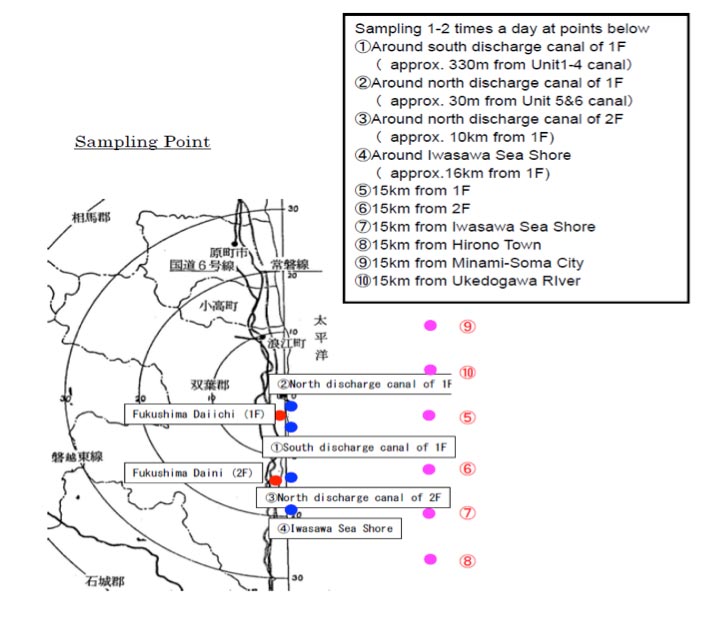
Until 3 April a general decreasing trend was observed at the sampling points TEPCO 1 to TEPCO 4. After the discharge of contaminated water on 4 April, a temporary increase has been reported. On 10 April new data (7 April sampling day) for all TEPCO sampling points have been reported. At the near-shore sampling points TEPCO 1, TEPCO 3 and TEPCO 4 a further decrease with respect to the results for the sampling day 5 April, in the concentration of I-131 and Cs-137 have been reported. At the sampling point TEPCO 2 a further increase in the concentration of I-131 (from about 40 kBq/l on 6 April to about 150 kBq/l) and Cs-137 (from about 25 kBq/l on 6 April to about 65 kBq/l) was observed.
For the six sampling points TEPCO 5 to TEPCO 10 on April 7 the following has been reported: as TEPCO 5, TEPCO 6 and TEPCO 10 a further decrease of the levels of I-131 below 0.2 kBq/l and of Cs-137 below 0.1 kBq/l were measured.
At TEPCO 7 an increase of the level of I-131 has been recorded. At TEPCO 8 and TEPCO 9 an increase in the levels of both I-131 and Cs-137 has been measured. The reading at TEPCO 9 is from about 0.07 kBq/l (6 April) to about 0.37 kBq/l for I-131 and from about 0.05 kBq/l to about 0.21 kBq/l for Cs-137.
MEXT Off-shore Monitoring Programme
As reported in the brief of 8 April MEXT initiated the off-shore monitoring program on 23 March and subsequently points 9 and 10 added to the off-shore sampling scheme. On 4 April, MEXT added two sampling points to the north and west of sampling point 1. These are referred to as points A and B on the map below.
Map 2: MEXT Seawater Sampling Locations:
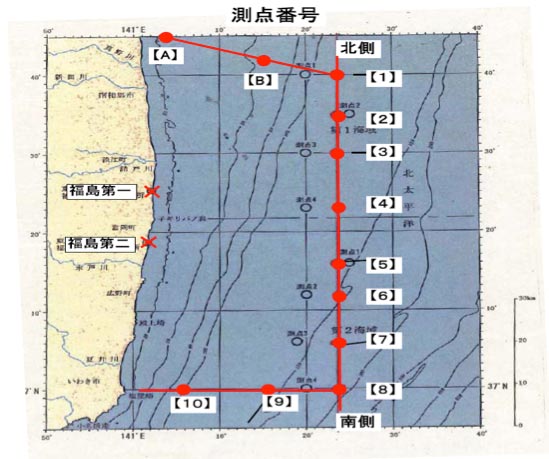
On 10 April new data have been reported (7 April sampling day) for the sampling points MEXT 6 and MEXT 10. At MEXT 6 sampling point an increase in I-131 (from about 18 Bq/l on 3 April to about 57Bq/l) and Cs-137 (from about 10Bq/l on 3 April to about 20 Bq/l) has been measured. At MEXT 10 the level of I-131 remains about 35 Bq/l as on 3 April; Cs-137 is no longer detectable.
No new data for the other sampling points have been reported at the date of 10 April.
4. IAEA Activities
The team of three Agency experts in BWR technology will conclude their mission on Monday with meetings with NISA, Ministry of Foreign Affairs (MOFA), MEXT, Atomic Energy Commission (AEC) and Nuclear Safety Commission (NSC).
In addition to those reported in previous briefs the following countries have submitted monitoring data and/or links to national websites where data is available: USA, Czech Republic and Latvia.
http://www.iaea.org/newscenter/news/2011/fukushima110411.html
14.45 Notes about the mistaken leakage of highly radioactive water.
Fukushima Nuclear Accident Update (6 April 2011, 08:15 UTC)
Leakage of Highly Contaminated Water into Sea
According to Japanese authorities, the leak of highly contaminated water from the cable storage pit located next to the Unit 2 inlet point at Fukushima Daiichi nuclear power plant has stopped as of 20:38 UTC on 5 April.
Workers had employed measures to stop the flow of water directly to the sea since 2 April, when the leak was first observed.
On April 2, concrete was poured into the pit in an attempt to stop the water leakage to the ocean, but no significant decrease in leakage was observed.
From 4:47 UTC to 5:30 UTC on 3 April, the top of the trench was broken open and polymer was poured into the trench to stop the leakage of water, but this measure was not successful.
Approximately 13 kg of liquid tracer was injected into the pit at 22:08 UTC, 3 April. The tracer was also injected into two new bore holes that had been drilled near the pit.
At 4:15 UTC, 5 April it was confirmed that the tracer was seen leaking from the crack into the sea.
At 6:07 UTC, 5 April coagulation agents (liquid glass) were injected into the holes drilled around the pits. The leakage was reported to have ceased at 20:38 UTC on April 5. Work continues to prevent further releases to the sea.
…
Seawater is collected daily close to the discharge areas of Units 1 – 4 and of Units 5 and 6 at the Dai-ichi NPP. The data show a decreasing trend from 1 to 3 April from about 66 kBq/l to 24 kBq/l for I-131 and 21 kBq/l to 10 kBq/l for both Cs-134 and Cs-137 at Units 1 – 4. The concentrations at Units 5 and 6 also showed a decreasing trend until 3 April. These values were measured before the discharge of low level contaminated water authorised by the Japanese Government on 4 April.
New data were provided for the off-shore survey on 8 sampling points about 30 km east of the NPPs. Concentrations are between 5 and 18 Bq/l for I-131 and between roughly 1 and 11 Bq/l for Cs-137. For the new coverage of the coastal transect in the south, about 35 km south of Fukushima Daiini, the highest concentrations were detected at the sampling point closest to the coast in the south with about 38 Bq/l for I-131 and 4.5 Bq/l for Cs-137. The concentrations at all sampling points have decreased over time.
http://www.iaea.org/newscenter/news/2011/fukushima060411.html
14.32 Notes about the scheduled release of radioactive water into the environment.
Fukushima Nuclear Accident Update (5 April 2011, 20:25 UTC)
Japan Begins Discharge of Low Level Radioactive Water
Japanese authorities have confirmed to the IAEA that they began to discharge 11 500 tonnes of low level radioactive water from the Fukushima Daiichi nuclear power plant into the sea on 4 April. The operation is being conducted to create storage capacity for highly radioactive water that has pooled in parts of the reactor facility, hindering efforts to restore electrical power from the grid to the facility.
Japanese officials have reported that they plan to release 10 000 tonnes of water from a waste treatment facility and 1 500 tonnes from drainage pits around reactor Units 5 and 6. The operation is expected to last no more than five days.
http://www.iaea.org/newscenter/news/2011/fukushima050411.html
13.52 NISA have decided to raise the level of the Fukushima nuclear incident to the highest level 7 on the International Nuclear and Radiological Event Scale, the same as that of Chernobyl. It is important to note, however, that the actual situation at Fukushima has not changed much. The update is to reflect the now recorded data on radiation released and the impacts it has had on the environment.
Live updates have slowed down a lot here recently and I have not been posting all the minor events, but rest assured that I have been monitoring the situation on Twitter and the news. I will continue to post relevant information when I can.
The Japanese government’s nuclear safety agency has decided to raise the crisis level of the Fukushima Daiichi power plant accident from 5 to 7, the worst on the international scale.
The Nuclear and Industrial Safety Agency made the decision on Monday. It says the damaged facilities have been releasing a massive amount of radioactive substances, which are posing a threat to human health and the environment over a wide area.
The agency used the International Nuclear and Radiological Event Scale, or INES, to gauge the level. The scale was designed by an international group of experts to indicate the significance of nuclear events with ratings of 0 to 7.
On March 18th, one week after the massive quake, the agency declared the Fukushima trouble a level 5 incident, the same as the accident at Three Mile Island in the United States in 1979.
Level 7 has formerly only been applied to the Chernobyl accident in the former Soviet Union in 1986 when hundreds of thousands of terabecquerels of radioactive iodine-131 were released into the air. One terabecquerel is one trillion becquerels.
The agency believes the cumulative amount from the Fukushima plant is less than that from Chernobyl.
Officials from the agency and the Nuclear Safety Commission will hold a news conference on Tuesday morning to explain the change of evaluation.
Tuesday, April 12, 2011 05:47 +0900 (JST)
http://www3.nhk.or.jp/daily/english/12_05.html
13.42 #Quakebook is now on sale! After weeks of waiting on publishers (the book was ready in a week!), we can finally announce that it is available for Kindle on Amazon.co.uk and Amazon.com. Be sure to grab your copy and buy a few for friends and relatives. ALL proceeds go to the Japanese Red Cross. Truly amazing.
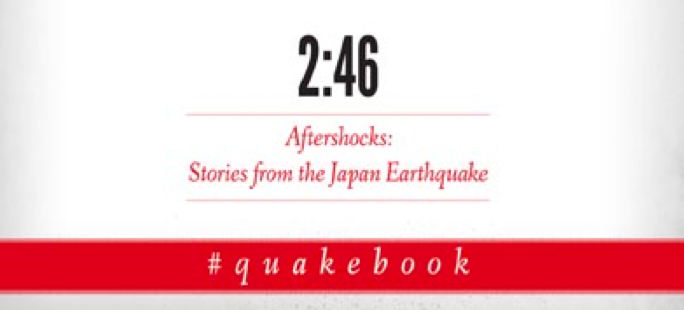
April 12th, 2011
00.01 The Japan Seismic Hazard Information Station (J-SHIC) shows the latest (2010) predications for seismic danger zones in Japan. It will be interesting to see how this map changes when the agency releases the new maps for 2011.
The graph above shows the probability of a weak level 6 or greater quakes occurring within the next 30 years. The most problematic areas are in a dark red colour. The Japanese quake scale (Shindo) goes from 1-7, but generally quakes of level 6 or higher are powerful enough to cause big problems.
In the graph above, red colour shows areas that have an increased probability of weak level 6 or greater quakes occurring within the next 30 years when compared with 2009. Blue colour denotes areas that show a decreased probability since 2009.
The graph above shows the probability of quakes of varying powers occurring across Japan within the next 30 years. As you can see, the area near Miyagi and the areas in the Tokai region are especially prone to strong (Shindo 6-7) earthquakes.
http://www.j-shis.bosai.go.jp/?lang=en
http://www.jishin.go.jp/main/chousa/10_yosokuchizu/index.htm
April 10th, 2011
22.42 Lee from Tokyotimes pointed me towards a fantastic documentary made by the BBC which takes a balanced look at the recent earthquake. It puts the quake in historical perspective and discusses how it links to potential future quakes. It’s well worth a watch, and you can easily find the file on torrent sites online. The link below has a few possible sources. I checked Fileserve a few minutes ago for a direct download and it was working. Here’s a sample of the Horizon documentary:
http://www.youtube.com/watch?v=ePCuG1zT_YU
In a nutshell: it is extremely difficult to predict when earthquakes will strike (an experiment in Parkfield, America during the 1990s showed this), but we can predict the areas where they are likely to occur. Earthquakes are also locally linked. In other words, a quake occurring in one region of Japan will lower built up pressure on the plates in that area, but consequently increase pressure on other connected plates. This is why we get lots of immediate aftershocks and, crucially, why there is a very high chance that the recent M9 quake could lead to another serious quake in surrounding regions, including Tokyo.
NHK were also discussing the results of a MEXT investigation into the possibility of a series of 3 connected M9 strength quakes from the Tokai, Tonankai and Nankai plates spanning 700km across the coast of Japan.
http://www.irfree.com/bbc-horizon-special-2011-japan-earthquake-pdtv-xvid-p2p/
http://www.nikkei.com/news/latest/article/g=96958A9C93819695E2E5E2E08B8DE2E5E2E6E0E2E3E39180EAE2E2E2
http://www.yomiuri.co.jp/e-japan/okayama/news/20110408-OYT8T01028.htm
April 9th, 2011
15.16 NHK reporting that the blue lights were probably caused by the Sendai transformer substation, owned by Tohoku Electric. The position in the video is where the station is located and a team checked the site by helicopter and found evidence of burning. An electrical short is thought to have occurred which caused the transformer to stop working for a period of time yesterday evening. As of this morning (8th), the functionality has been restored. A further investigation is underway.
http://www3.nhk.or.jp/news/html/20110408/k10015180611000.html
13.35 Information about a curious luminescent phenomenon that likely occurred late last night when the M7 quake struck Miyagi prefecture. It also may have been due to an electrical arc discharging when the power lines snapped. Not yet confirmed if the true source has been found.
Known as Earthquake Lights. They have a white-bluish hue and usually last for several seconds. They have been documented many times in the past and while there are several theories that attempt to explain the lights, but the mechanism is still unknown.
You can view the footage taken by NHK clearing showing the light here:
http://www.youtube.com/watch?v=zgooTL9hEc0
http://twitpic.com/4hycka
http://no-sword.jp/blog/2011/03/earthquake_lights_over_edo.html
http://www.grn.janis.or.jp/~matu-jma/yougo/mat-swarm.html
http://inamidst.com/lights/earthquake
02.12 Information from NISA about the latest quake and status of the plants. 2 out of 3 external power connections lost at Onagawa. Cooling systems for spent fuel pools went offline initially as the quake struck, and came back online afterwards. Other plants in various places are operating at various levels with backup diesel generators. At Fukushima Daiichi, work continues to dose units with cooling water. No increases of radiation detected at Onagawa or Fukushima.
http://kinkyu.nisa.go.jp/kinkyu/2011/04/post-100.html
http://kinkyu.nisa.go.jp/kinkyu/2011/04/035.html
http://kinkyu.nisa.go.jp/kinkyu/2011/04/100.html
02.07 Illustrations showing the various nuclear power plants around Japan. With the recent quake, there is a possibility that further damage may have been done. As of now though, TEPCO has said that no further damage to either of the Fukushima plants has occurred.
http://www.enecho.meti.go.jp/topics/hakusho/index.htm
http://twitpic.com/photos/daniel_garcia_r
01.01 A couple of images taken from the live NHK stream about the recent quake. http://www.ustream.tv/channel/kamori
Power outages being reported in Aomori, Iwate, Akita and also parts of Miyagi, Yamagata. Tsunami warnings have been lifted.
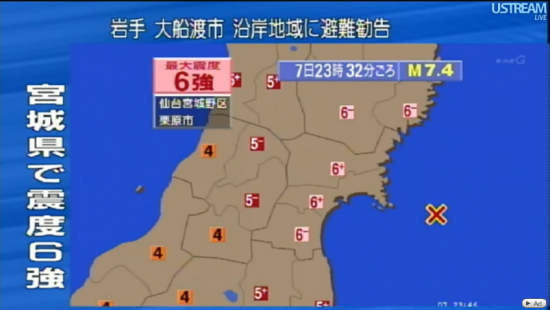
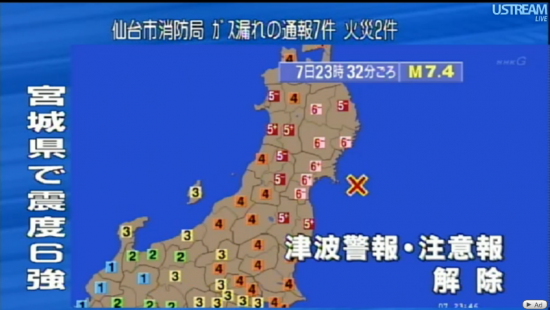
00.32 A Shindo 6 (roughly M7.4) quake hit the Tohoku region at 23.32 on April 7th. Tsunami warnings were issued. This quake is the biggest since the initial set on March 11th. Currently no change in the radiation readings at Fukushima Daiichi have been recorded, but 2 external power sources have reportedly gone down at the Onagawa nuclear power plant. Various areas of Miyagi prefecture are without power.
http://www.jma.go.jp/jp/quake/20110407233726353-072332.html
http://www.nikkansports.com/general/news/f-gn-tp0-20110408-758260.html
http://www3.nhk.or.jp/news/html/20110408/t10015171141000.html
http://www3.nhk.or.jp/news/html/20110408/t10015170841000.html
http://www3.nhk.or.jp/news/html/20110408/k10015171751000.html
April 8th, 2011
**End Live Updates**
12.23 Apologies for the lack of informational updates, but I’ve been working on the new website for http://www.quakebook.org. We’re moving the site from Blogger to WordPress. It should be completed and live fairly soon, and the book itself in a matter of days! It has taken longer than expected (mainly due to waiting on Amazon and other companies to give to go ahead and agree to waive their fees – which they have!), but it’ll all be worth it in the end. All proceeds go to charity and reconstruction efforts and financial aid will be required long into the months ahead, so your contribution will be very well appreciated, even long after the initial quake. Price of the book is to be $9.99.
April 5th, 2011
01.23 Once source of the contaminated water leaking out into the sea has been discovered. Behind unit 2 at Fukushima Daiichi Nuclear Plant a 20cm crack was discovered in a 2m maintenance pit containing about 10-20cm of water with readings of 1000mSv/h. TEPCO are trying to fill the crack with concrete to stop the leak but as of 23.00 it has not been possible because the concrete is not hardening. The pit is connected to a tunnel where power cables are laid, which is also connected to the trench, where more water with high levels of radiation has been discovered. TEPCO are instead planning to inject a special polymer which absorbs water and expands, which should hopefully stop the leak. The work will begin from tomorrow morning on 3rd April.
http://www3.nhk.or.jp/news/html/20110402/k10015063281000.html
http://www3.nhk.or.jp/news/html/20110402/t10015069361000.html
00.53 Some good news! A lonely dog was found wandering around on a pile of debris 1.8km out at sea from the port of Kesennuma and successfully rescued. It looks as though the dog could have been out at sea for 3 weeks since the quake and tsunami struck, but it appears in good health.


http://www3.nhk.or.jp/news/html/20110402/k10015068581000.html
April 3rd, 2011
23.48 New photos taken by an unmanned drone from above Fukushima Daiichi Nuclear Power Plant. Lots more pictures at the site itself, but in the photo below, you can see the units 1-4, top to bottom.
http://cryptome.org/eyeball/daiichi-npp/daiichi-photos.htm
http://www.youtube.com/watch?v=M22Gt4sswEA
April 2nd, 2011
**End Live Updates**
01.22 Latest on reactors from the IAEA:
IAEA Briefing on Fukushima Nuclear Accident (31 March 2011, 14.00 UTC)
by International Atomic Energy Agency (IAEA) on Thursday, 31 March 2011 at 23:10
1. Current SituationOverall at the Fukushima Daiichi plant, the situation remains very serious.
The Unit 1 condenser is full. Pumping water from the Unit-1 turbine building basement to the Unit-1 condenser has been stopped as of 22:30 UTC on 28 March. For Units 2 and 3, in order to prepare for removal of the water from the turbine building basement, pumping of water from the condenser to the suppression pool water surge tank started at 07:45 UTC 29 March and 08:40 UTC March 28 respectively.
For Unit 1 fresh water has been continuously injected into the Reactor Pressure Vessel (RPV) through the feed-water line at an indicated flow rate of 8 m3/h using a temporary electric pump with diesel backup. In Unit 2 fresh water is injected continuously through the fire extinguisher line at an indicated rate of 8 m3/h using a temporary electric pump with diesel backup. In Unit 3 fresh water is being injected continuously at about 7 m3/h into the reactor core through the fire extinguisher line using a temporary electric pump with diesel backup.
The indicated temperature at the feed water nozzle of the RPV on Unit 1 has decreased from 281 oC to 251 oC and at the bottom of RPV decreased from 134 oC to 128 oC. There appears to be a corresponding decrease in RPV pressure with a slight decrease in Drywell pressure. The indicated temperature at the feed water nozzle of the RPV of Unit 2 has increased from 177 oC to 181 oC. The temperature at the bottom of RPV was not reported. Indicated Drywell pressure remains at atmospheric pressure. The indicated temperature at the feed water nozzle of the RPV in Unit 3 is about 89 oC and at the bottom of RPV is about 114 oC. The validity of the RPV temperature measurement at the feed water nozzle is still under investigation.
No further information is available regarding the plan to commence the pumping of water into the Unit 1 Spent Fuel Pool by concrete pumping truck from 29 March. On Unit 2 the temporary electric pump supplying water to the spent fuel pool experienced a malfunction. Spent fuel pool water supply was changed to a fire truck pump but a crack was discovered in a hose on 30 March 04:10 UTC. Pumping water to the spent fuel pool was therefore stopped. Pumping was subsequently restored and water was fed into spent fuel pool in Unit 2 from 10:05 UTC on March 30. Water injection into the spent fuel pool in Unit 4 by concrete pump was completed at 09:33 UTC on March 30.Units 5 and 6 remain in cold shutdown.
2. Radiation Monitoring
On 30 March, deposition of iodine-131 was detected in 8 prefectures, and deposition of cesium-137 in 12 prefectures. On 30 March in the prefectures where deposition of iodine-131 was reported, the range was from 2.5 to 240 becquerel per square metre. For caesium-137, the range was from 3 to 57 becquerel per square metre. In the Shinjyuku district of Tokyo, the daily deposition of both iodine-131 and cesium-137 on 30 March was below 30 becquerel per square metre. No significant changes were reported in the 45 prefectures in gamma dose rates compared to yesterday.
Most of the previously imposed recommendations for restrictions on drinking have been lifted. As of 28 March, recommendations for restrictions based on I-131 concentration remain in place in four villages of in the Fukushima prefecture, in three of these villages, restrictions continue to apply for infants only.
Two IAEA teams are currently monitoring radiation levels and radioactivity in the environment in Japan. On 30 March, one team made gamma dose-rate measurements in the Tokyo region at 7 locations. Gamma-dose rates measured ranged from 0.03 to 0.28 microsievert per hour, which is within or slightly above the background. The second team made additional measurements at 7 locations in the Hirono area, South of Fukushima-Daiichi NPP. The measurement locations were at distances of 23 to 39 km from the Fukushima nuclear power plant. The dose rates ranged from 0.5 to 4.9 microsievert per hour. At the same locations, results of beta-gamma contamination measurements ranged from 0.04 to 0.34 Megabecquerel per square metre.
Since our briefing of yesterday, significant data related to food contamination has been submitted by the Japanese Ministry of Health, Labour and Welfare. Seventy-six samples were taken from 28-30 March, and reported on 30 March. Analytical results for 51 of the 76 samples for various vegetables, fruit (strawberry), seafood (sardines), and unprocessed raw milk in eight prefectures (Chiba, Fukushima, Gunma, Ibaraki, Kanagawa, Niigata, Saitama, and Yamagata), indicated that iodine-131, caesium-134 and caesium-137 were either not detected or were below the regulation values set by the Japanese authorities. However, it was reported that analytical results in Fukushima prefecture for the remaining 25 of the 76 samples for broccoli, cabbage, rapeseed, spinach and other leafy vegetables, indicated that iodine-131 and/or caesium-134 and caesium-137 exceeded the regulation values set by the Japanese authorities.
The Joint FAO/IAEA Food Safety Assessment Team met with local government officials in Gunma prefecture on Wednesday. Farmers and producers were also represented and the meeting attracted media coverage. The questions to the IAEA/FAO team mainly focused on technical issues of remediation strategies, including the implications of long term releases if the NPP is not stabilized, the disposal of contaminated produce, mechanisms of 131I and 137Cs contamination, other possible radionuclides that may be produced/should be monitored, contamination of fruit and mushrooms, occupational exposure risks in the handling animals and agricultural products, feeding strategies for animals in affected areas, monitoring of soil and fallout and remediation strategies and methodologies. There were also discussions with producers and farmer organizations over the development of strategies for the next cropping season.
Local government officials briefed the FAO/IAEA Team on current knowledge of the extent of contamination in Gunma prefecture, including the principal agricultural products affected and levels of contamination found.
The Joint FAO/IAEA Team presented their report and responded to inquires at a follow-up inter-ministerial meeting in Tokyo. The meeting was attended by representatives of the Japanese Cabinet Office, Ministry of Foreign Affairs, Ministry of Health, Labour and Welfare and the Ministry of Agriculture. Strong interest was expressed as to the remediation of the agricultural land, continued possible contamination of agricultural products, and the need to maintain communication with relevant ministries in the future.
New results from the marine monitoring stations 30 km off-shore were reported for 28 March. These results indicate a decrease for the northernmost sampling station for I-131 and a slight increase for Cs-137 as compared to values measured on 27 March. For sampling points situated towards the south of the transect an increase has been recorded, both for I-131 and for Cs-137 as compared to the previous day, with maximum concentrations in water below 30 Bq/l and 20 Bq/l respectively, still considerably lower than the maxima recorded on 23 March. This increase can be correlated with trends in concentrations measured close to the discharge points.
The latest analyses in seawater 330 m south of the discharge point of NPP Units 1 – 4, and 30 m north of the discharge point of Units 5-6 were made available for 29 March. In particular readings of 130 000 Bq/l of I-131, 32 000 Bq/l of Cs-137 and 31 000 Bq/l of Cs-134 were reported near Units 1 – 4.
The Russian Federation, Singapore, Ireland and Switzerland reported the detection of very small amounts of iodine-131 and cesium-137 in air. Highest levels found are in the order of a few millibecquerel per cubic meter. The levels are not of any radiological concern.
http://www.facebook.com/note.php?created&¬e_id=206240456072415&id=96699782061
01.13 Here’s the latest Fleep.com graphs. Be sure to visit his site to check out other prefectures. I’ve only included the main places here for reference on how things have been developing over the last few days. Iodine levels in water are thankfully dropping back down now.
Radiation levels in Fukushima:
Iodine levels in water:
00.46 More updated graphs of the radiation readings. This time a special version from my pal Daniel on Twitter who works at a Japanese Atomic Energy Agency. He has been collecting the live data from Ibaraki from the start in order to keep his family informed who live out there.
Very interesting are the clear comparisons he has made on the graph. Tokyo background radiation levels have never gone above the standard background radiation in Europe, except briefly when the explosions happened.
Many Europeans live with background radiation of levels between 100 – 200 nSv/h (nano sieverts, so in micro sieverts that is 0.1uSv-0.2uSv/h). Current levels in Tokyo are averaging 0.1uSv/h.
Notice how the spikes in the graphs are caused by the hydrogen explosions and that the higher figures in more recent days are due to wet weather.
http://twitpic.com/4fcal3
http://cid-0b14c7ab35e39ebd.office.live.com/view.aspx/QuakeInfo/IbarakiAdsorbedDoseEvolution.xlsm
http://twitpic.com/4ej8gw
http://eurdepweb.jrc.ec.europa.eu/PublicEurdepMap/Default.aspx
April 1st, 2011










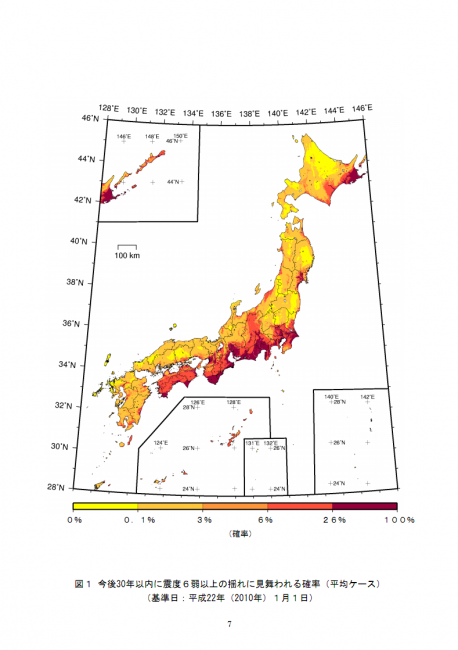
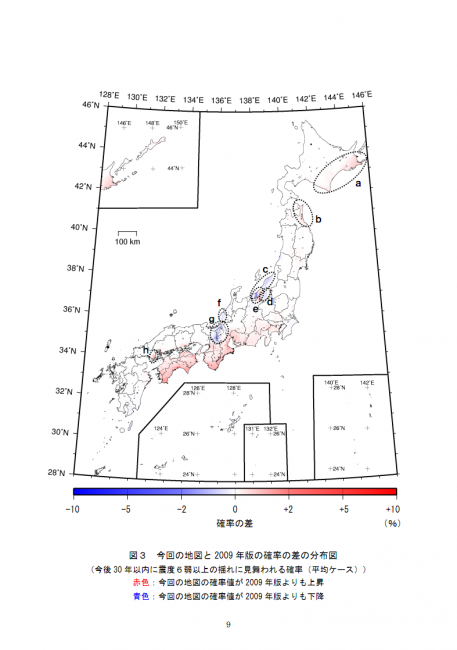
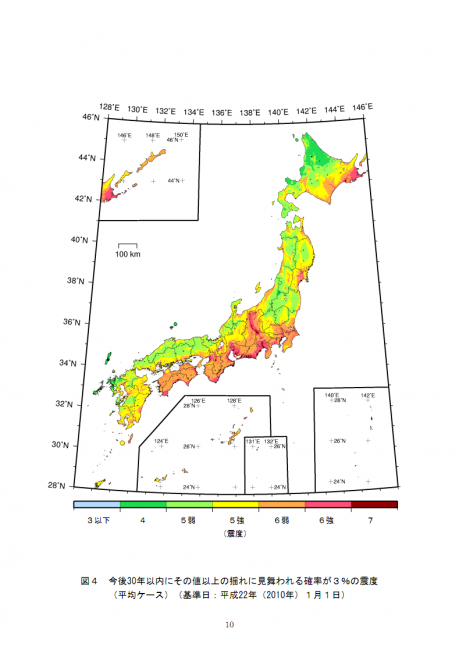
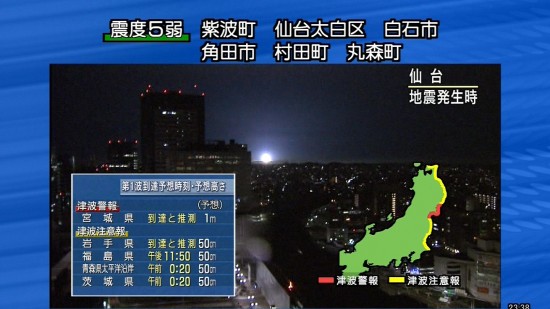
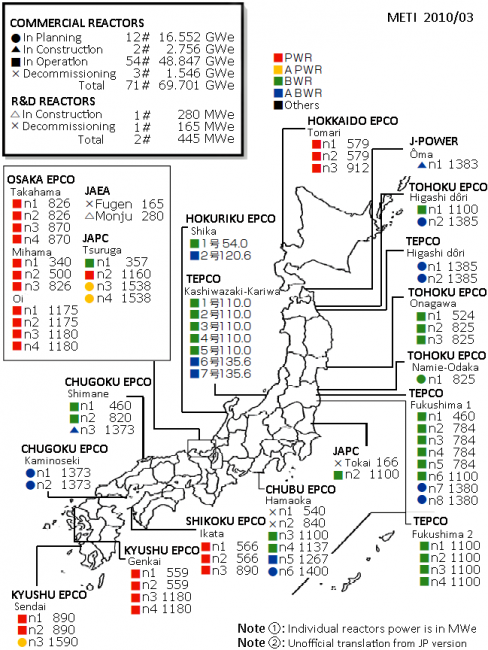


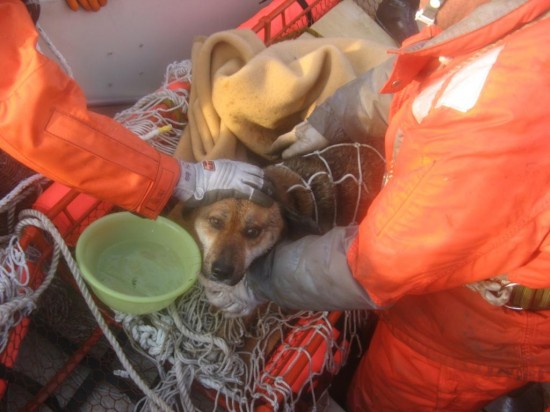
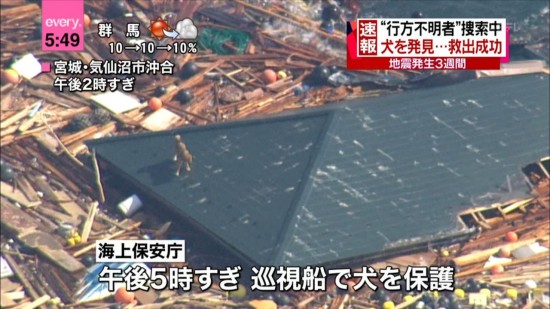
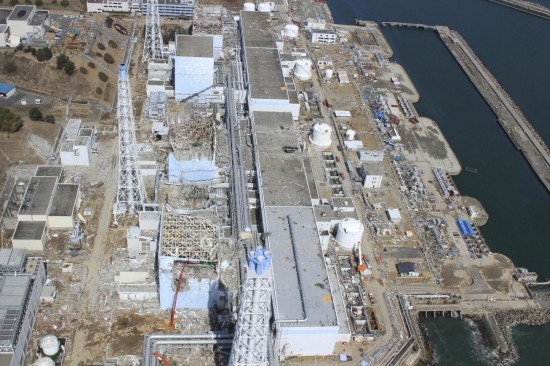

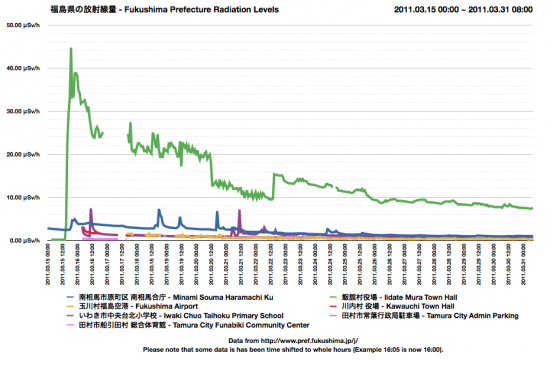
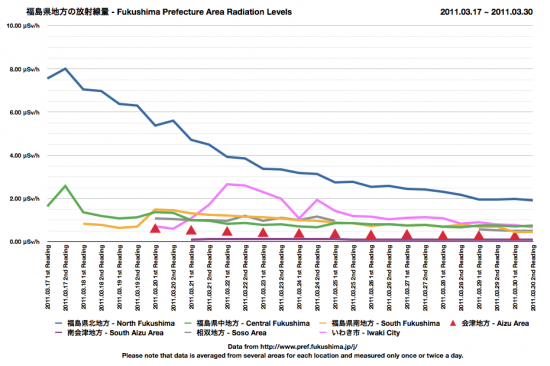
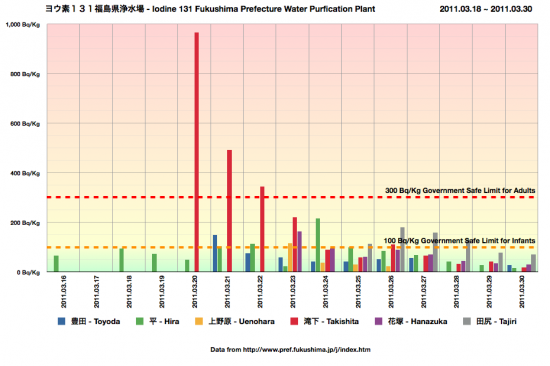
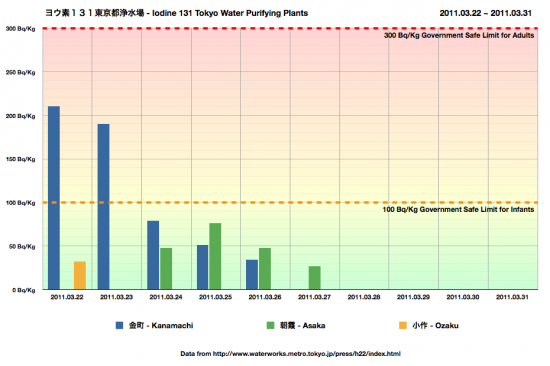
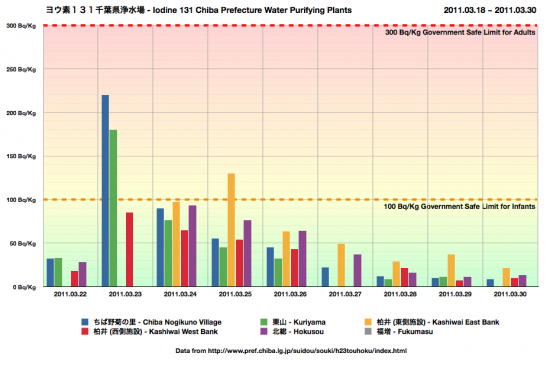

No miracle that 99.8% of the schoolkids survived
How the children of Kamaishi got through the tsunami
Almost all the elementary and junior high school children of Kamaishi,
a small coastal town in Iwate, managed to survive the tsunami.
Many people said it was a miracle, but it wasn’t.
The response capabilities they learned at school helped them to overcome a disaster that exceeded all worst-case scenarios.
http://wedge.ismedia.jp/articles/-/1334
“It struck at 14.46 with a magnitude of 9.0 and was assigned the highest level 7 on the Japanese earthquake scale.”
Just a note about the Kishōchō (JMA) shindo scale: there isn’t just one shindo rating for an earthquake. Areas that experience shaking each have their own shindo rating based on the level of shaking in that area. Whereas magnitude indicates the scale of energy released by a seismic event, the JMA shindo scale indicates what sort of effects the earthquake has on each area. For me, the March 11 earthquake was only shindo 3 because I was in Aichi.
That’s right – it was Shindo 3 for me too!
The figures aren’t total crap, but the article is. After discussing it on Twitter, I found out that the 3 pCi/l standard quoted is based on a lifetime (70 year) consumption at that level. 3 picocuries are equal to about 0.111 Becquerels (extremely low). Also, since Iodine-131 has a half-life of 8 days, it’s extremely unlikely that the level would be drank fro that long. In short, the article is mostly fearmongering.
http://www.epa.gov/radiation/japan-faqs.html#rainwater
http://www.epa.gov/japan2011/rert/radnet-sampling-data.html#milk
http://www.fda.gov/downloads/NewsEvents/PublicHealthFocus/UCM251056.pdf
Thanks for the reply and the updates :). I was having troubles figuring out what the picocuries actually meant.
Great work done here!